| □ | The Payments Form allows you to: |
| • | Specify the Date and the Amount that is to be Paid |
| • | Apply that Payment to one or more outstanding Bills of your choosing |
| • | Record Hand Written Checks and Electronic Payments |
| • | Void a Check, and/or Un-Allocate a Payment |
| □ | Making Payments using the Payments Form: |
| • | Press F-4 to open the Vendor Information Form and use F-2 to Select the Vendor to whom you want to make a Payment. |

| • | The Payments Form for the Selected Vendor will be displayed. |

Payments Form
| • | This Payments Form may be Re-sized by Dragging the Top and/or Bottom up or down, and/or the Right side in or out. |
| • | Navigation Menu - The Navigation Menu is located at the top of the Payments Form. |

| • | This Navigation Menu provides the normal Record Movement, New, Edit, Delete, Cancel, Save, Refresh and Search options. |
| • | Record Editing section - The details of the currently selected record are displayed below the Navigation Menu at the center (Main Body) of the Payments Form. |
| • | Table View tab - A tabular (spreadsheet style) Table View of the currently defined Payments is accessible by Clicking the Table View tab at the bottom of the Payments Form. |

| • | To display a specific Payment record in the Record Editing section, Click on that record within the Table View section. |
| • | This Table View information may be Pinned in Place by Clicking the Pin Icon on the right. |

Payments Form - with Table View tab Pinned Open
| ▪ | You may Un-Pin this Table View by Clicking the Pin Icon again. |
| ▪ | Click on any listed record to display that information in the center (Main Body) of the Form. |
| • | There are many columns of data in this Payments Listing. |
| • | Each column's Header Name describes the data contained in that column. |
| ▪ | Clicking on a Header Name will set the order in which the Payments will be listed. |
| ▪ | Clicking on the same Header Name will set the order in the opposite direction (ascending vs. descending). |

| ▪ | The Header Name that is determining the Order of the list will have an Icon indicating the Order displayed next to that Header Name. |
| • | To enter a Payment to be issued to a Vendor: |
| • | Click the  Icon to start the Payment entry in the Record Editing section. Icon to start the Payment entry in the Record Editing section. |
| ► | Note: The PaymentID is the system assigned record number which is inserted automatically when the Payment record is initially saved and only appears in the Payments Listing section. |
| ▪ | Date Paid - Today is the default date. Use the Drop-Down Date Selection Box to change the date. |
| ▪ | Amount Paid - Enter the amount of the payment you wish to make. |
| ▪ | Bank Account - Use the Drop-Down Selection List to Choose the Bank from which you want to draft these funds. |
| ▪ | Check Number - If this will be a system generated Auto Check, the Check Number will be assigned when the Check is actually printed (see the related Auto Check, Hand Check and Ebill information in the "Payment Type" section below). |
| ▪ | Batch Number - By default it will be the day number of Today's date. Enter the desired Batch Number. |
| o | Setting The Batch Number - It is best to keep this simple. However: |
| a) | Batch Numbers may be assigned from 1 to 32637 (this limitation is a function of the field type into which you are entering this Batch Number). |
| b) | A new numbering sequence may be started each month (using the current Date's Day number), so the same Batch Number will be used in multiple Months but the date will be different. |
| c) | In some cases, the same Batch Number may be used for more than one day to group certain of these types of payments together. |
| d) | Starting from 1 and increment the Batch Number perpetually (if you used 2 batch numbers for two deposits every day, 5 days a week, it would take over 60 years to use all of the numbers) is another option. |
| e) | The down side of incrementing the Batch Number perpetually is that the next number to be used needs to be maintained manually. |
| f) | The recommended method is that each month starts a new sequence so the same Batch Number will be used in multiple Months because inMKMS the records for Payments are automatically stored internally by Date and Batch Number to keep them differentiated. |
| ▪ | Payment Type - Click the button that identifies the type of Payment: |
| o | Auto Check - By default, this button will be selected and the Check Number will be inserted automatically when the Check is actually Printed. |
| o | EPay - Click this button to record a Payment that was made via an Electronic Transfer from the Selected Bank Account and deposited directly into the Bank Account of the Selected Vendor. |
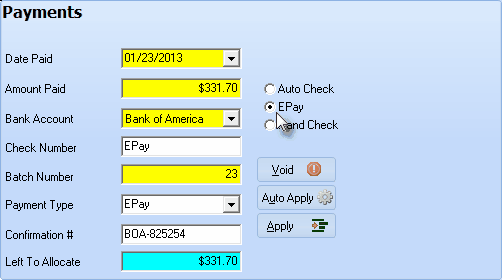
Payments Form - EBill entry of an Electronic Payment
| a) | Batch Number - By default, it will be the day number of Today's date. Enter the appropriate Batch Number if it is different. |
| b) | Payment Type - Use the Drop-Down Selection List provided in the Payment Type field to Choose EPay. |
| c) | Confirmation # - Enter the the Confirmation Number if provided by the Bank |
| d) | Check Number - EPay is inserted in Check Number field automatically. |
| o | Hand Check - Click this button to record a Hand Written Check (see the "To enter a Hand Written Check Payment" section below). |
| ▪ | Confirmation # - If this Payment was made via an Electronic Funds Transfer, enter the Confirmation Number if provided by the Bank, or if not, enter some other notation to clearly identify it, if appropriate. |
| o | Because an Electronic Funds Transfer to a Vendor using your personal or business banking software has no MKMS assigned Check Number, the Check Number field will automatically display as EPay. |
| ▪ | Left To Allocate - Initially, this will be the Amount you entered for this Check. |
| o | Once you Apply some or all of the Payment (see Applying Payments using the Allocations Form below), the system will adjust the Left To Allocate value accordingly - reducing it as you Apply all (or portions) of the Payment to outstanding Bill(s). |
| • | To enter a Hand Written Check Payment: |
| ▪ | Hand Check - To enter a Payment made with a Check that was Hand Written, Click this button. |
| ▪ | Check Number - Enter the Check Number you used for the Hand Written Check. |
| o | This is a mandatory field so the Payment entry can not be saved until a Check Number has been entered. |
| o | Be sure the Check Number is not a number that falls within the range of your normal Check Numbering Sequence. |
| o | Alternately, if using the next Check Number in the Check Book (or box, bundle, etc.), reset the Last Check Number field in the Bank Maintenance Form (for the Bank Account that was selected above) with the Check Number used for the Hand Check. |
| o | This will "use" that Check Number and so the Print Checks function will assigned the correct Next Check Number appropriately. |
| • | Click the  Icon to record this entry. Icon to record this entry. |
| • | The system will assign a Payment ID. |
| • | Repeat this process, as needed. |
| □ | Special Buttons on the Payments Form: |
| • | Applying this Payment to one or more Bill(s): |
| • | When you have determined what Bill(s) this Payment should be applied to, you may use one of two methods: |
| 1. | Click the Auto Apply button to automatically distribute this Payment from the oldest to the newest Bill, based their Due Date - until there is nothing Left To Allocate, or |
| 2. | Click the Apply button opens the Allocations Form which allows you to specifically designate the Bill(s) to which this Payment is to be applied. |
| • | In either case, when you Print the Checks, information will be printed on the Check Stub explaining to that Vendor exactly what Bills you intended to pay with these funds. |
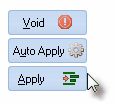
Payments Buttons
| • | Void - Checks get lost in the mail, damaged in the printer, paid to the wrong person, etc., and so will need to be voided within the system. |
| • | Voiding a Check cancels the payment and locks the Check Number so it cannot be re-used, and also maintains a permanent record of the cancellation. |
| • | Click the Void to Void the currently selected Payment entry. |
| • | Confirm that you want to Void this Payment. |
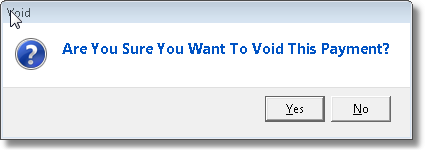
Void Confirmation message
| • | You may be asked to Authorize this transaction. |
| • | If so, enter the appropriate message stating clearly why the transaction is to be canceled and who authorized the cancellation.. |
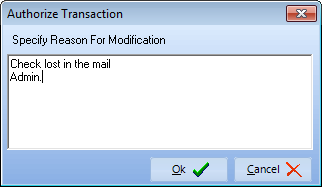
Authorization to Void a Payment may be required
| • | If the Payment has already been allocated to a Bill, you will first have to UnAllocate the distribution of that Check. |
| • | UnAllocate Confirmation - Select Both to completely UnAllocate the Payment in preparation for the Void Payment procedure. |
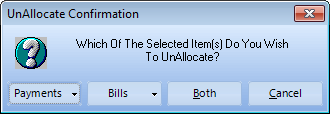
UnAllocate Confirmation message
| • | When the Void process is finished, the Payments Form will indicate that this transaction is Voided. |

Payments Form with a Voided transaction
| • | The Left To Allocate field will be set to $0.00 |
| • | The Check Number will be Voided internally but the record of the transaction will remain - though the Monies Paid (which will still show in the record for reference purposes) will have been removed. |
| • | General Ledger users will see this Payment amount being Credited (added back) to the appropriate General Ledger Accounts Payable account, and Debited (added back) into the appropriate General Ledger Asset account for the Bank from which the Voided Check was drawn. |
.
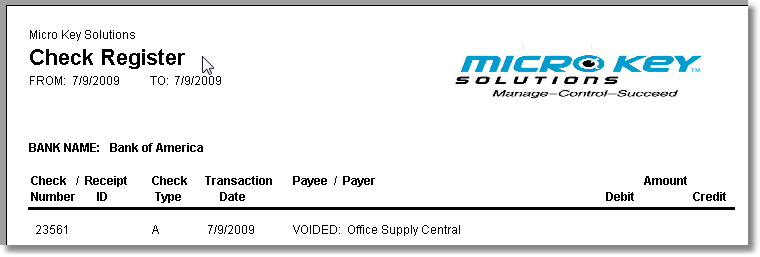
Check Register showing a Voided Check transaction
| ◆ | Also see the Applying Payments chapter with instructions on using the Allocations Form for additional information relating to completing the Payments process. |
| □ | Using the Search Function on the Navigation Menu at the top of the Payments Form: |
| • | Search - Click the Search Icon to open the Search Payments dialog. |
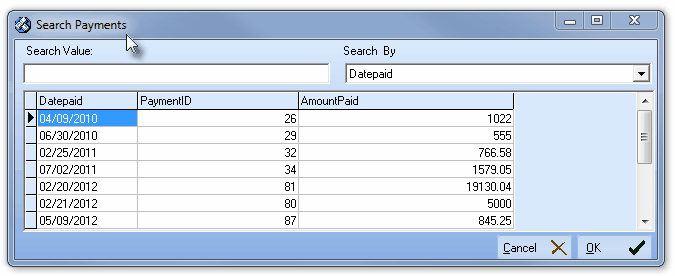
Search Payments dialog
| • | See the "Using the Generic Search dialog" section in the Advanced Search Dialog chapter for more information about this Search dialog. |








![]()


![]()

![]()







